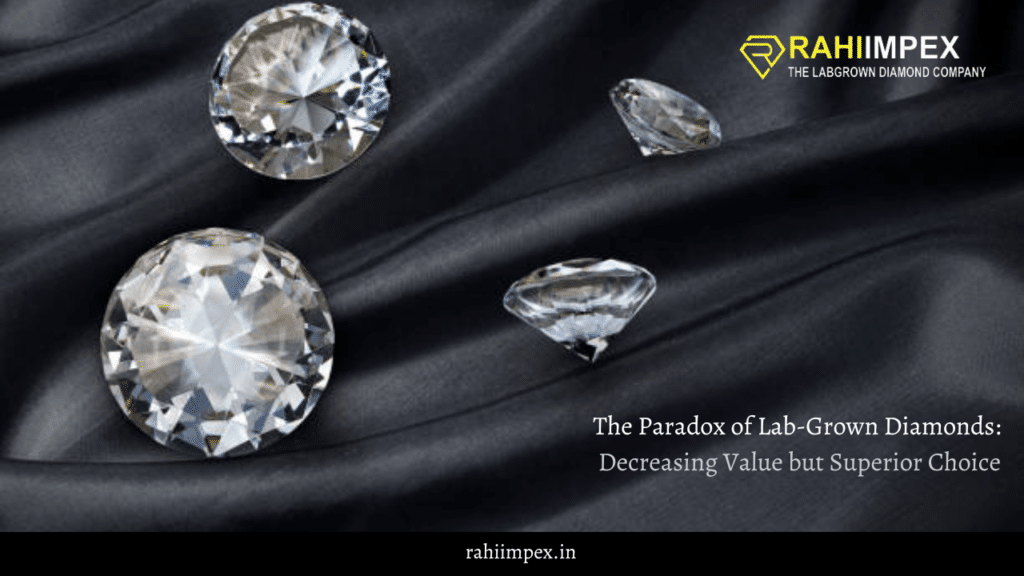Lab-grown diamonds, also known as synthetic diamonds, are becoming increasingly popular in the diamond market. They are created in a controlled environment by a lab-grown diamond manufacturer, which allows for a more efficient and cost-effective production process. This is one of the reasons why lab-grown diamonds are typically less expensive than natural diamonds.
However, despite their lower cost and similar physical and chemical properties to natural diamonds, lab-grown diamonds have been facing a paradox in recent years: their value is continuously decreasing. This is because the demand for lab-grown diamonds is increasing, leading to a surplus in the market. As a result, lab-grown diamond manufacturers in India are lowering their prices to stay competitive.
Increase awareness
Despite this decrease in value, lab-grown diamonds are still a superior choice for consumers. For one, they are more ethically and environmentally friendly than natural diamonds, which are often mined in war-torn regions and can cause harm to the environment. Lab-grown diamonds are also a more budget-friendly option for consumers, as they are less expensive than natural diamonds.
Furthermore, India is one of the largest lab-grown diamond manufacturers in the world. The lab-grown diamond industry in India has been growing rapidly, as it is a cost-effective and sustainable alternative to natural diamond mining. Indian lab-grown diamond manufacturers are known for their high-quality products and competitive prices, which makes them a popular choice among consumers.
Greater flexibility they offer
Additionally, lab-grown diamonds offer greater flexibility in terms of customization and design. Since they are created in a controlled environment, manufacturers have more control over the final product, which allows for a greater variety of shapes, sizes, and colors. This means that consumers can find a lab-grown diamond that perfectly suits their taste and style, without compromising on quality or cost.
Another advantage of lab-grown diamonds is that they are often more transparently sourced and tracked than natural diamonds. Many lab-grown diamond manufacturers provide detailed information about their production process and can even offer certifications that verify the authenticity and quality of their products. This can give consumers peace of mind when purchasing a lab-grown diamond, knowing that they are getting a high-quality product that is ethically and sustainably produced.
Quality and appearance they hold
The lab-grown diamond industry has also seen significant advancements in technology and production methods. This has led to a significant increase in the quality and appearance of lab-grown diamonds, making them virtually indistinguishable from natural diamonds to the naked eye. This has further increased the appeal of lab-grown diamonds among consumers.
It’s also worth noting that lab-grown diamonds have a greater potential for appreciation in value compared to natural diamonds. As the demand for lab-grown diamonds continues to rise and the technology for producing them improves, it’s likely that their value will increase as well.
Conflict-free option
Lab-grown diamonds are also conflict-free, as they are not mined in war-torn regions, which is a major concern for many buyers. They also don’t involve the exploitation of workers, unlike natural diamond mining.
Advantage they hold
It is also worth mentioning that lab-grown diamonds have a smaller carbon footprint than natural diamonds. The process of mining natural diamonds requires a significant amount of energy and resources and can have a negative impact on the environment. On the other hand, lab-grown diamonds are created in a controlled environment using renewable energy sources, which greatly reduces their environmental impact.
Another advantage of lab-grown diamonds is that they are often more consistent in terms of quality and size compared to natural diamonds. Natural diamonds are formed over millions of years and can vary greatly in terms of quality and size, which can be a concern for consumers. Lab-grown diamonds, on the other hand, are created in a controlled environment, which allows manufacturers to produce diamonds that are consistent in terms of quality and size.
It’s a matter of time
Lab-grown diamonds can be produced in a matter of weeks, as opposed to natural diamonds which can take millions of years to form. This allows for faster and more efficient production, which can help to keep costs low for consumers.
A better choice for investment
Lab-grown diamonds are a better investment option as they are more affordable and accessible than natural diamonds, which are often only available to the wealthy. The affordability of lab-grown diamonds means that more people can afford to purchase them and enjoy the benefits that diamonds can bring. This can also help to make diamonds more inclusive, which is a trend that we are seeing in the diamond industry. The affordability of lab-grown diamonds means that more people can afford to purchase them and enjoy the benefits that diamonds can bring. This can also help to make diamonds more inclusive, which is a trend that we are seeing in the diamond industry.
IN CONCLUSION
Lab-grown diamonds offer many advantages over natural diamonds. They are more affordable, ethically and environmentally friendly, and have a smaller carbon footprint. Indian lab-grown diamond manufacturers have a great reputation for producing high-quality, beautiful, and affordable lab-grown diamonds, which makes them an excellent option for those considering purchasing a lab-grown diamond. The advancements in technology and production methods have also made lab-grown diamonds more consistent in terms of quality and size, and they are becoming increasingly indistinguishable from natural diamonds. This makes lab-grown diamonds an attractive option for anyone looking for a diamond that is both cost-effective and ethically sound.







Your article helped me a lot, is there any more related content? Thanks!